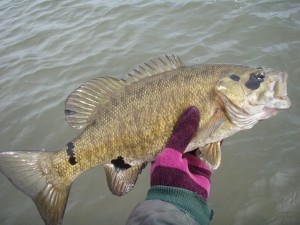Pa. DEP Secretary Rejects Calls for Greater Federal Protections for Susquehanna River
-
Susan Phillips

Courtesy of William Yingling
Black spots on a fish caught in the Susquehanna River continue to stump state researchers.
The Pennsylvania Department of Environmental Protection has decided not to seek an “impaired” status for the Susquehanna River under the Clean Water Act, rejecting a plea from the state’s Fish and Boat Commissioner John Arway. Last April, Arway wrote a letter to DEP Secretary Michael Krancer, describing in detail increased incidents of “black-spotted” fish turning up in the river.
Arway told Krancer the appearance of black spots on adult fish is new, and only seen since the summer of 2011. A survey showed 40 percent of the adult small mouth bass within a section of the river had black spots. So far, no one has an answer for what’s causing the lesions.
To comply with the Clean Water Act, the state is required to send a biannual assessment of the state’s waterways to the Environmental Protection Agency. In that report, the DEP could request waterways to be listen as “impaired,” which affords the river greater protection. In a press release, Secretary Krancer says the decision not to request the Susquehanna River be listed as impaired is based on “sound science.”
“While we recognize that the Pennsylvania Fish and Boat Commission and others had requested that DEP propose to impair a 98-mile stretch of the Susquehanna River,” wrote Krancer, “as we have pointed out on many occasions before, that view is based on very limited, piecemeal data and is not supported by the existing data or the law.”
Krancer says the agency will continue to study the cause of the lesions, as well as intersexing, in cooperation with the Fish and Boat Commission, the Susquehanna River Basin Commission, and the U.S. Geological Survey. In the meantime, he says no one has made a connection between water quality and changes in the health of the fish.
“Our scientists also tell me that no cause and effect can be established right now between water quality and the tumors and lesions found on adult bass. It is not at this point clear how prevalent the tumors and inter-sex conditions are throughout the river, nor if they are related to the young-of-year die-offs,” Krancer said. “It is important to note that the Fish and Boat Commission has not reported any diseased young-of-year in the lower Susquehanna this past summer.”
Possible causes for the lesions or intersexing could be hormonal changes from endocrine disrupters, viruses or other environmental impacts. In his April 4, 2012 letter, Fish and Boat Commissioner John Arway says intersexing, which can be caused by endocrine disruptors, is occurring among fish in the Susquehanna River and urged Krancer to conduct more studies.
“Unfortunately, the type and quality of data needed to characterize the contaminants leading to endocrine disruption in the Susquehanna River are lacking,” wrote Arway. “While the science behind monitoring these parameters is still developing, knowledge of this information as part of this investigation is of utmost importance.”
Arway also told Secretary Krancer that Shad stocks are not making it down river to the ocean.
The “impaired” listing, known as 303(d), would mean the river would come under certain federal criteria for discharges of pollutants, and studies would be prioritized to determine what is causing disease among the fish. States create new lists every two years.
















